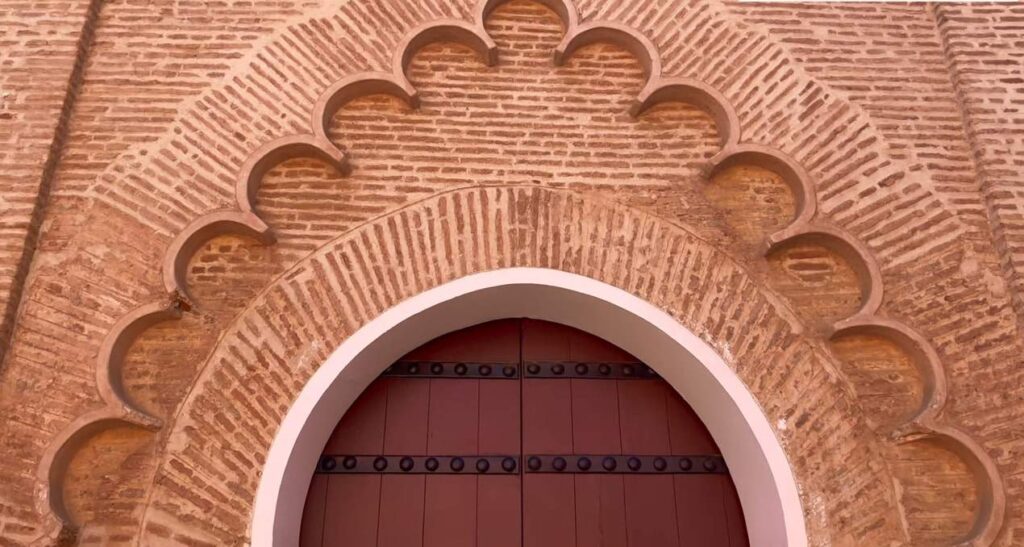Standing as a magnificent testament to Morocco’s rich history and Islamic heritage, the Koutoubia Mosque is an architectural masterpiece nestled in the heart of Marrakech.
Dating back to the 12th century, this iconic landmark boasts a mesmerizing blend of intricate design elements and grandeur, capturing the essence of Almohad architecture.
From its towering minaret to its expansive prayer halls, the mosque exudes a sense of timeless elegance and spiritual significance. Join me as I take this journey to explore the captivating history, exquisite architecture, and cultural significance of the illustrious Koutoubia Mosque.
What is the History of the Koutoubia Mosque?

The Koutoubia Mosque, a prominent symbol of Marrakech, boasts a rich history dating back to the 12th century. It was commissioned by the Almohad Caliph Abd al-Mu’min in 1147, following the Almohads’ conquest of the city from the Almoravid dynasty.
The mosque’s name, derived from the Arabic word for “bookseller”, reflects its proximity to a historic bookseller’s market that once thrived nearby.
The construction of the Koutoubia Mosque marked the beginning of Almohad architectural influence in Morocco, characterized by grand structures and intricate detailing. Initially, two mosques were built on the site.
The first was constructed hastily and deemed unsuitable, prompting the caliph to commission a second, more structurally sound mosque.
Completed in 1157, the mosque features a distinctive minaret that rises 77 meters high, making it one of the tallest structures in Marrakech.
The minaret is adorned with intricate carvings, horseshoe arches, and a unique blend of Almohad and Andalusian architectural styles. It served as a prototype for other significant towers, including the Giralda of Seville and the Hassan Tower in Rabat.
Over the centuries, the Koutoubia Mosque has remained a vital religious site, continuing to draw worshippers and visitors alike. Its enduring presence highlights the historical and cultural significance of Islamic architecture in North Africa.
Why is the Koutoubia Mosque Famous?
The Koutoubia Mosque is famous for several reasons, making it a standout landmark in Marrakech and an iconic symbol of Islamic architecture.
Built in the 12th century, Koutoubia Marrakech is one of the largest in the country and exemplifies Almohad architecture with its striking design and grandeur.
The mosque minaret, towering at 77 meters, is particularly renowned, serving as a model for the Giralda in Seville and the Hassan Tower in Rabat.
Since the Mosque’s name literally translates to “Booksellers’ Mosque” reflects its historical location near a bustling book market, symbolizing the city’s rich intellectual and cultural heritage.
Additionally, the Joutoubia Mosque’s historical importance as a center of worship and its influence on subsequent Islamic architectural designs contribute to its fame. Its enduring presence and striking silhouette against the Marrakech skyline continue to attract visitors and admirers worldwide.
Koutoubia Mosque Architecture & Design

The Koutoubia Mosque in Marrakech is a brilliant example of Almohad architecture, renowned for its harmonious design and grand scale.
Constructed in the 12th century under the rule of Almohad Caliph Abd al-Mu’min, the mosque exemplifies the simplicity and grandeur characteristic of Almohad architectural principles.
This mosque boasts a captivating blend of brick and sandstone adorned with turquoise-blue earthenware motifs. Its grandeur extends beyond its facade, as inside, visitors are greeted by over 100 columns and 17 majestic naves.
With a prayer area resembling the shape of a T, it stands as one of the largest halls in the Western world, accommodating over 20,000 worshippers. At its pinnacle stands the awe-inspiring minaret, soaring so high and crowned with a golden arrow visible from 29 kilometers away.
Legend shrouds the origin of the golden balls adorning the minaret’s summit, with tales ranging from treasures of the Caliph’s wives to symbolic representations of elemental forces or significant mosques.
The mosque’s layout follows the traditional Arab hypostyle plan, featuring a spacious courtyard surrounded by a portico and a prayer room with columns.
Restored to its former glory in 1990 by the Moroccan Ministry of Culture, the Koutoubia Mosque continues to stand as a testament to Islamic architecture and cultural heritage.
Is Koutoubia Mosque Free to Visit?
Yes, the Koutoubia Mosque is free to visit for worshippers and tourists alike.
As a place of religious significance and cultural heritage, the mosque welcomes visitors to admire its architecture, serene courtyard, and historic ambiance without any admission fee.
However, access to certain areas, such as prayer halls, may be restricted during prayer times. Visitors are encouraged to respect the mosque’s sacred nature and adhere to any guidelines or dress codes in place.
Guided tours may be available for those interested in learning more about the mosque’s history and significance, though these may involve a fee.
Are Non-Muslims Allowed in the Koutoubia Mosque?
While the Koutoubia Mosque warmly welcomes non-Muslim visitors to admire its architectural splendor and cultural significance, access to certain areas, such as the prayer halls, may be restricted during prayer times out of respect for worshippers.
However, outside of these times, non-Muslims are generally permitted to explore the mosque’s grounds and courtyard freely. It’s important to be mindful of prayer times, which occur five times a day, as access to interior spaces may be limited during these periods.
Photography in the Koutoubia Mosque is often permitted in designated areas of the mosque, allowing visitors to capture the beauty of its intricate architecture and serene surroundings.
Overall, non-muslims can appreciate the magnificence of the Koutoubia Mosque while respecting its sacred traditions and practices.
Conclusion
The Koutoubia Mosque stands as a symbol of Marrakech’s rich cultural heritage and architectural prowess. Its soaring minaret, intricate design, and serene ambiance make it a must-visit destination for travelers and worshippers alike.
Whether admiring its beauty from afar or exploring its historic grounds up close, visitors are sure to be captivated by the mosque’s timeless elegance and spiritual significance.
As a beacon of Islamic art and culture, the Koutoubia Mosque continues to inspire awe and reverence, inviting all who encounter it to reflect on the enduring legacy of faith and tradition in Morocco’s vibrant landscape.
